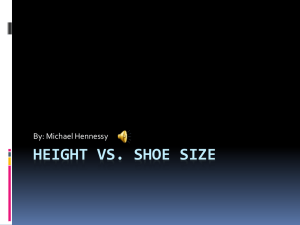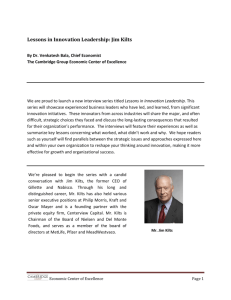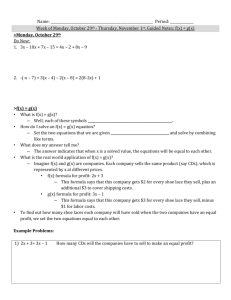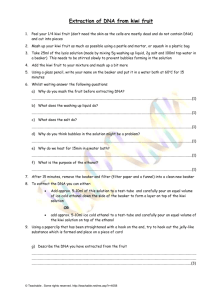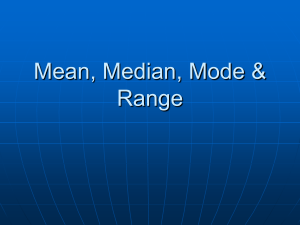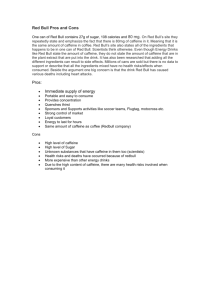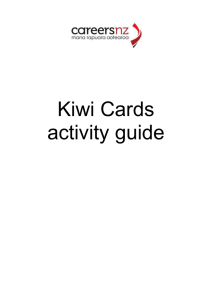Gillette and the Razor Market Trends and Case Studies
advertisement
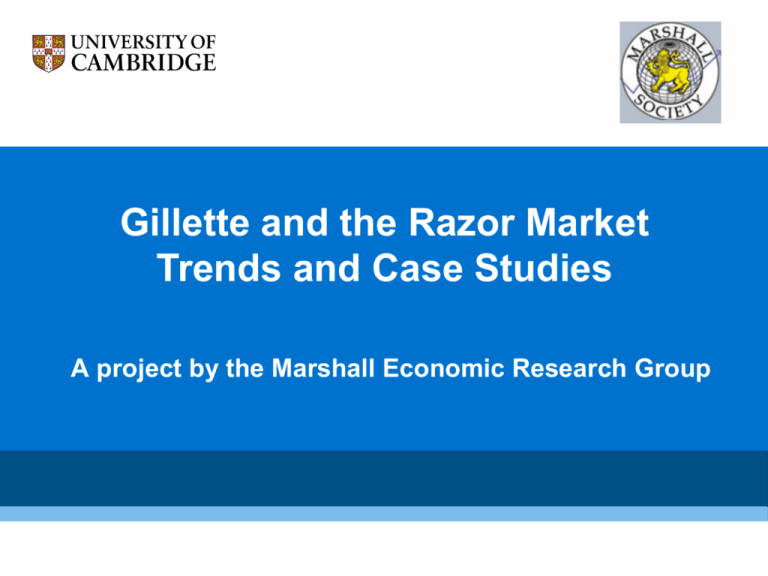
Gillette and the Razor Market Trends and Case Studies A project by the Marshall Economic Research Group Outline TRENDS IN THE RAZOR MARKET THE ECONOMETRIC ESTIMATION CASE STUDY: KIWI AND THE SHOE POLISH MARKET CASE STUDY: REDBULL AND THE ENERGY DRINKS MARKET More beards in recent years • Metrosexual / hipster trend in Western Europe and North America • Socially accepted and propagated by media Can this be the reason for the observed decline in Gillette market share? Gillette Market Shares (%) 32 France 22 UK USA Germany 12 2 2005 2006 2007 2008 2009 2010 2011 2012 2013 Social trends are intangible and unpredictable • “There is no actual evidence that beards have peaked or are in decline as a fashion statement or anything else.” – Keith Flett of Beard Liberation Front Approaching peak beard • “We may have reached peak beard.” - Prof. Rob Brooks, social anthropologist at the UNSW Australia • “…beards are on the wane…” - The Guardian • “Let’s face it, this beard’s gone feral” - Schick ad campaign While “hard” economic dynamics might be somehow more persistent… • Part-time employment Hypothesis: in Part-time rate ~ razor sales • Employment of the young Hypothesis: in youth employment ~ razor sales • Job sector Hypothesis: in Service Sector workers ~ razor sales Outline TRENDS IN THE RAZOR MARKET THE ECONOMETRIC ESTIMATION CASE STUDY: KIWI AND THE SHOE POLISH MARKET CASE STUDY: REDBULL AND THE ENERGY DRINKS MARKET Our methodology to estimate these impacts Specify a model with nineteen developed countries with similar features in the 2005-2012 interval Use the coefficients to compute the estimates for analysis and forecasting Countries Included Australia, Austria, Canada, Denmark, Finland, France, Germany, Greece, Italy, Japan, Netherlands, Norway, Portugal, Spain, Sweden, Switzerland, United States, United Kingdom Our results The model The Implications • An increase by 1% in the Part Time to Total Employment ratio leads to a decrease in the Gillette Market Share by 0.29% • An increase by 10% in the Labour Force Participation of younger people leads to an increase in Gillette Market Share by 0.65% • An increase by 10% in the Service Sector ratio of employment leads to an increase in Gillette Market Share by 0.6% Using the Estimates for Forecasting Framework • We use the estimates for the 2005-2012 model to “forecast” the market share for 2013. This allows us to evaluate the quality of the model Gillette Actual and Predicted Market Share for 2013 Country Actual Predicted France 27.8 28.2 Germany 21.3 20.4 United Kingdom 29.3 30.0 USA 30.4 27.2 Conclusions • • The model seems to be able to forecast reasonably well for European countries. It does not perform similarly for the US, possibly because the market has a different structure Outline TRENDS IN THE RAZOR MARKET THE ECONOMETRIC ESTIMATION CASE STUDY: KIWI AND THE SHOE POLISH MARKET CASE STUDY: REDBULL AND THE ENERGY DRINKS MARKET Shoe Polish Market Characteristics Low sales volume Low value Consumer demand inelastic Infrequently purchased Shoe Polish Market Characteristics Target consumers: 25-44 years old Non user Male shoe care users Female shoe care users 38% 37% 63% 25% Timeline 1906 1984 2011 Traditional Sales Strategy Legacy Brand Recognition Product dominance • Used by Allied troops since WW1: still has a higher market share in Allied countries • Using kiwi is like a tradition for some • Niche market that started off as a product of social status symbol • Brand loyalty • Simply better than other products quality wise • Does not dry up leather like other polishes Adjusting to new market trends Increased Product Line • Decrease in sales due to more casual footwear (e.g. sneakers) from 1980s onward Kiwi introduced new foot-care products, including shoe inserts, heel cushions, and anti-slip pads and strips Expand Targeted Groups • Developed specific products for women, which Kiwi had previously ignored New merchandising System • Integrated their new foot-care products and traditional shoe-shine products into a single aisle, to facilitate the shopping experience Kiwi: wrap-up Expand Consumer Group Conduct Extensive Market research New Merchandising System Kiwi maintains dominance Outline TRENDS IN THE RAZOR MARKET THE ECONOMETRIC ESTIMATION CASE STUDY: KIWI AND THE SHOE POLISH MARKET CASE STUDY: REDBULL AND THE ENERGY DRINKS MARKET Timeline • Started in Austria 1987 • Created the global market for energy drinks 2002 • Monster enters the energy drinks market 2013 • Red Bull still dominates the market with 5 billion cans annually Current Market Shares Historical Market Shares Redbull and Monster Sales (US $ million) 4,000 3,500 3,000 2,500 Redbull 2,000 Monsters 1,500 1,000 500 0 2010 2011 2012 2013 Traditional Sales Strategy “Cool” Image Extreme Sports “Red Bull gives you wings” Risk-taking attitude Adjusting to market trends: how to face Monsters “Coolness” Factor • Marketing done mainly through extreme sports events, like Red Bull Air Race and Formula 1 • Red Bull also gained popularity through bars and other alcohol-serving establishments all over the world Alcoholic Drinks • Vodka Red Bull, which has led to dangerous effect on health but nevertheless raises the brand’s association with “fun” Wrap up: how to face Monsters competition Energy drinks replacing soda drinks Entire energy market still growing Main target consumers are young people Continuing growth for Red Bull Concluding Remarks The importance of employment trends Kiwi: the ability to adapt to market trends Trends in the razor market: not just the “hipster-mania” Red Bull: the importance of targeted marketing
